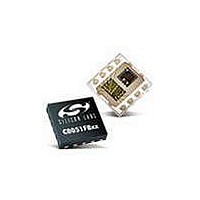Si1120-A-GM Silicon Laboratories Inc, Si1120-A-GM Datasheet - Page 14

Si1120-A-GM
Manufacturer Part Number
Si1120-A-GM
Description
Industrial Optical Sensors Proximity/Ambient Light Snsr w/PWM Out
Manufacturer
Silicon Laboratories Inc
Type
Ambient Light Sensor with Analog Outputr
Datasheet
1.SI1120-A-GM.pdf
(20 pages)
Specifications of Si1120-A-GM
Product
Integrated Ambient Light and Proximity Sensor
Output Type
Analog - Voltage
Maximum Operating Temperature
+ 85 C
Minimum Operating Temperature
- 40 C
Lead Free Status / RoHS Status
Lead free / RoHS Compliant
Available stocks
Company
Part Number
Manufacturer
Quantity
Price
Part Number:
Si1120-A-GMR
Manufacturer:
SILICON LABS/芯科
Quantity:
20 000
Si 1120
2.5. Choice of LED and LED Current
In order to maximize detection distance, the use of an infrared LED is recommended. However, red (visible) LEDs
are viable in applications where a visible flashing LED may be useful and a shorter detection range is acceptable.
Red LEDs do not permit the use of infrared filters and thus are more susceptible to ambient-light noise. This added
susceptibility effectively reduces the detection range. White LEDs have slow response and do not match the
Si1120’s spectral response well; they are, therefore, not recommended.
The Si1120 maintains excellent sensitivity in high ambient and optically noisy environments, most notably from
fluorescent lights. In very noisy environments, the maximum sensitivity may drop by a factor of up to one hundred,
causing a significant reduction in proximity range. With reduced sensitivity, the effect of optical environmental noise
is reduced. For this reason, it is best to drive the LED with the maximum amount of current available, and an
efficient LED should be selected. With careful system design, the duty cycle can be made very low, thus enabling
most LEDs to handle the peak current of 400 mA while keeping the LED’s average current draw on the order of a
few microamperes. Total current consumption can be kept well below that of a typical lithium battery's self-
discharge current of 10 µA, thus ensuring the battery's typical life of 10 years.
Another consideration when choosing an LED is the LED's half-angle. An LED with a narrow half-angle focuses the
available infrared light using a narrower beam. When the concentrated infrared light encounters an object, the
reflection is much brighter. Detection of human-size objects one meter away can be achieved when choosing an
LED with a narrower half-angle and coupling it with an infrared filter on the enclosure.
2.6. Power-Supply Transients
2.6.1. V
Supply
DD
The Si1120 has good immunity from power-supply ripple, which should be kept below 50 mVpp for optimum
performance. Power-supply transients (at the given amplitude, frequency, and phase) can cause either spurious
detections or a reduction in sensitivity if they occur at any time within the 300 µs prior to the LED being turned on.
Supply transients occurring after the LED has been turned off have no effect since the proximity state is latched
until the next cycle. The Si1120 itself produces sharp current transients, and, for this reason, must also have a bulk
capacitor on its supply pins. Current transients at the Si1120 supply can be up to 20 mA.
2.6.2. LED Supply
If the LED is powered directly from a battery or limited-current source, it is desirable to minimize the load peak
current by adding a resistor in series with the LED’s supply capacitor. If a regulated supply is available, the Si1120
should be connected to the regulator’s output and the LED to the unregulated voltage, provided it is less than 6 V.
There is no power-sequencing requirement between VDD and the LED supply. The typical LED current peak of
400 mA can induce supply transients well over 50 mVpp, but those transients are easy to decouple with a simple
R-C filter because the duty-cycle-averaged LED current is quite low.
2.6.3. LED Supply (Single Port Configuration)
When using a single optical port, the Si1120 attempts to detect changes in reflection that can be less than one
percent of the received signal. A constant LED current is essential to avoid spurious detections. It is, therefore,
critical to prevent TXO saturation. If TXO is allowed to saturate in a single-port configuration, the Si1120 will be
very sensitive to LED power-supply variations and even to frequency variations at the STX input. A reservoir
capacitor should be chosen based on the expected TXO pulse width, and a series resistor should be selected
based on the STX duty cycle.
2.6.4. LED Supply (Dual Port Configuration)
When using separate optical ports for the LED and for the Si1120, the signal reflected from the target is large
compared with the internal reflection. This eliminates the need for keeping the LED current constant, and the TXO
output can, therefore, be allowed to saturate without problem. In addition, only the first 10 µs of the LED turn-on
time are critical to the detection range. This further reduces the need for large reservoir capacitors for the LED
supply. In most applications, a 10 µF capacitor is adequate. A 100 to 1 k resistor should be added in series to
minimize peak load current.
14
Rev. 1.0











